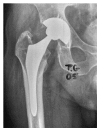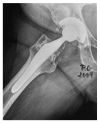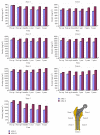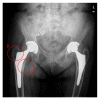Cementless hydroxyapatite coated hip prostheses
- PMID: 25802848
- PMCID: PMC4352755
- DOI: 10.1155/2015/386461
Cementless hydroxyapatite coated hip prostheses
Abstract
More than twenty years ago, hydroxyapatite (HA), calcium phosphate ceramics, was introduced as a coating for cementless hip prostheses. The choice of this ceramic is due to its composition being similar to organic apatite bone crystals. This ceramic is biocompatible, bioactive, and osteoconductive. These qualities facilitate the primary stability and osseointegration of implants. Our surgical experience includes the implantation of more than 4,000 cementless hydroxyapatite coated hip prostheses since 1990. The models implanted are coated with HA in the acetabulum and in the metaphyseal area of the stem. The results corresponding to survival and stability of implants were very satisfactory in the long-term. From our experience, HA-coated hip implants are a reliable alternative which can achieve long term survival, provided that certain requirements are met: good design selection, sound choice of bearing surfaces based on patient life expectancy, meticulous surgical technique, and indications based on adequate bone quality.
Figures










References
-
- Engh C. A., Bobyn J. D., Glassman A. H. Porous-coated hip replacement. The factors governing bone ingrowth, stress shielding, and clinical results. Journal of Bone and Joint Surgery—Series B. 1987;69(1):45–55. - PubMed
-
- Pilliar R. M., Lee J. M., Maniatopoulos C. Observations on the effect of movement on bone ingrowth into porous-surfaced implants. Clinical Orthopaedics and Related Research. 1986;(208):108–113. - PubMed
Publication types
MeSH terms
Substances
LinkOut - more resources
Full Text Sources
Other Literature Sources
Miscellaneous

